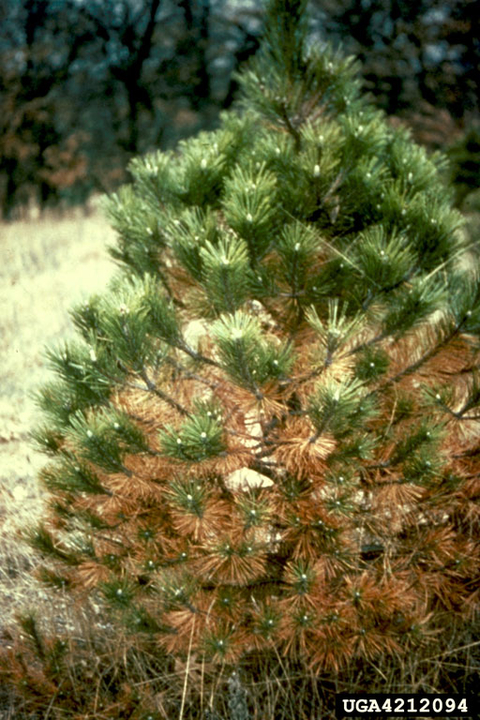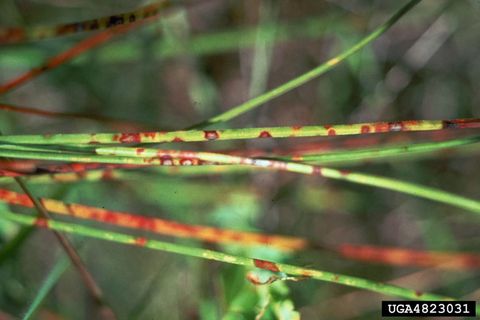Quick facts
-
Brown spot needle blight causes needle spots, browning and needle loss on pine trees.
-
Ponderosa and Scots pines are severely damaged by this disease in Minnesota.
-
Infected trees have slow growth and often have bare lower branches.
-
The disease can eventually kill young trees that have been infected year after year.
-
Risk of disease can be reduced by providing good air circulation around trees and keeping needles dry.
-
Fungicides can be used to protect trees from brown spot needle blight.
How to identify brown spot needle blight
Small, yellow-to-brown, resin-soaked spots form on needles throughout the summer.
Spots may occur on needles of all ages.
Needle tip dies and turns brown. The base of needle remains green with random yellow-to-brown spots in the center of the needle.
Within the spots, you may see tiny black bumps pushing through the surface of the needle. These small, pimple-like structures produce fungal spores.
In autumn, diseased needles turn reddish-brown and fall off leaving bare areas on the limb.
Infections are most common on lower branches and young trees.
Disease is most severe during long, warm, wet summer weather.
Lab analysis is often necessary to distinguish brown spot from Dothistroma needle blight. Submit a sample to the Plant Disease Clinic for testing.
Trees affected by brown spot needle blight in Minnesota
In the great lakes region, this disease causes significant damage to:
Ponderosa pine (Pinus ponderosa)
Scots pine (P. sylvestris)
All pine species in Minnesota can be infected with brown spot needle blight to some extent. The following pines may develop low levels of brown needle spot, but are rarely significantly damaged by the disease.
Jack pine (P. banksiana)
Mugo pine (P. mugo)
Austrian pine (P. nigra)
Eastern white pine (P. strobus)
Red pine (P. resinosa)
How does brown spot needle blight survive and spread?
Brown spot needle blight is caused by the fungus Mycosphaerella dearnessii (syn. Scirrhia acicola).
The fungus overwinters in diseased needles on the tree or on infected needles that have fallen from the tree.
In spring, spores are released and spread to new needles by splashing rain, wind or contaminated pruning tools.
Needles must be wet in order to be infected by these spores.
The majority of needle infections occur in spring and symptoms appear several months later.
New, succulent growth is most susceptible and is the quickest to show symptoms but all ages of needles can become infected.
Once the disease is in an area, annual infections occur as long as weather conditions are favorable.
How to manage brown spot needle blight
Maintain good air circulation around trees
This disease thrives under warm, wet conditions.
Don’t overcrowd plants. Use the mature size of the tree as a spacing guide when planting.
Remove the bottom most branches from the trunk to help increase air circulation around the tree.
Mulch under trees
Remove all weeds under the trees.
Maintain a 3 to 4 inch deep, even layer of wood chip mulch around your tree to prevent weed growth.
- Leave at least a 2 inch space between the mulch and the trunk to allow for air movement.
Do not mound the mulch around the trunk of the tree. Inspect the depth of the mulch layer each year. Add additional mulch only to maintain a 3 to 4 inch depth.
Don’t allow sprinklers to spray needles
If the tree is in a landscape with a sprinkler irrigation system, make sure that water is not spraying the needles.
When setting out sprinklers, direct the water away from needles.
Prune during dry weather
Prune and shear trees only when needles are dry.
If pruning trees infected with brown spot needle blight, sterilize pruning equipment between trees with a 10% solution of household bleach or a commercial disinfectant for pruning tools.
Fungicides
If trees have a history of infection with brown spot needle blight and forecasts predict persistent warm wet weather, fungicides can be used to protect the tree from further infection.
Apply a fungicide with copper sulfate or chlorothalonil as the active ingredient when needles are half-grown and again in 3 to 4 weeks.
CAUTION: Mention of a pesticide or use of a pesticide label is for educational purposes only. Always follow the pesticide label directions attached to the pesticide container you are using. Remember, the label is the law.
Reviewed in 2024



